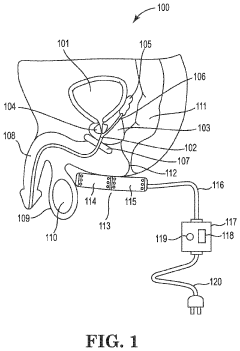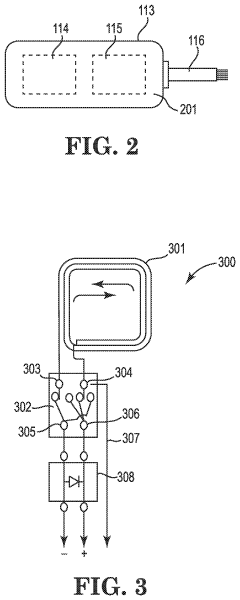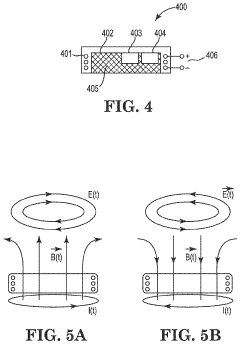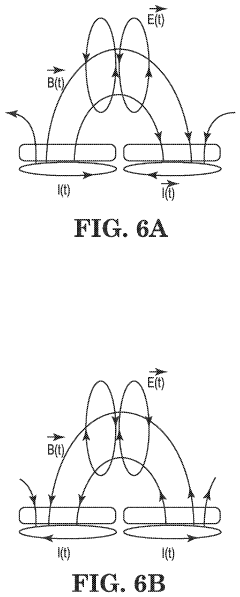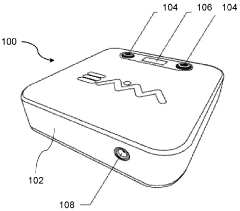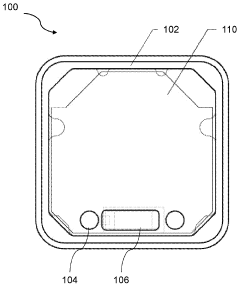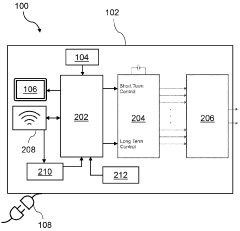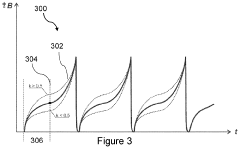Evaluating PEMF Therapy for Dermatological Applications
AUG 11, 20259 MIN READ
Generate Your Research Report Instantly with AI Agent
Patsnap Eureka helps you evaluate technical feasibility & market potential.
PEMF in Dermatology: Background and Objectives
Pulsed Electromagnetic Field (PEMF) therapy has emerged as a promising non-invasive treatment modality in various medical fields, including dermatology. The application of PEMF in dermatological treatments represents a convergence of electromagnetic physics and skin biology, offering potential benefits for a wide range of skin conditions.
The historical development of PEMF therapy can be traced back to the mid-20th century, with initial applications primarily focused on bone healing and pain management. Over the decades, researchers and clinicians have expanded their understanding of how electromagnetic fields interact with biological tissues, leading to a broader range of potential applications, including dermatology.
In the context of skin health, PEMF therapy aims to harness the body's natural healing processes by stimulating cellular activity and promoting tissue regeneration. The underlying principle involves the application of low-frequency pulsed electromagnetic fields to the skin, which can influence various cellular functions, including circulation, inflammation, and collagen production.
The objectives of evaluating PEMF therapy for dermatological applications are multifaceted. Primarily, researchers seek to establish the efficacy and safety of PEMF in treating common skin conditions such as wound healing, acne, eczema, and psoriasis. Additionally, there is growing interest in exploring its potential for anti-aging treatments and improving overall skin health.
One of the key goals is to determine the optimal parameters for PEMF therapy in dermatological treatments. This includes investigating the most effective frequencies, intensities, and durations of electromagnetic field exposure for different skin conditions. Researchers also aim to elucidate the precise mechanisms by which PEMF therapy influences skin cells and tissues at the molecular and cellular levels.
Another important objective is to compare the effectiveness of PEMF therapy with existing dermatological treatments. This comparative analysis helps to position PEMF therapy within the broader landscape of skin care and medical dermatology, potentially offering new treatment options for patients who have not responded well to conventional therapies.
Furthermore, the evaluation of PEMF therapy in dermatology seeks to explore its potential synergistic effects when combined with other treatment modalities. This includes investigating how PEMF might enhance the efficacy of topical medications, laser treatments, or other non-invasive skin therapies.
As the field of dermatology continues to evolve, there is a growing emphasis on personalized medicine. In this context, researchers are working to identify specific patient populations or skin conditions that may benefit most from PEMF therapy. This tailored approach aims to optimize treatment outcomes and minimize potential side effects.
The historical development of PEMF therapy can be traced back to the mid-20th century, with initial applications primarily focused on bone healing and pain management. Over the decades, researchers and clinicians have expanded their understanding of how electromagnetic fields interact with biological tissues, leading to a broader range of potential applications, including dermatology.
In the context of skin health, PEMF therapy aims to harness the body's natural healing processes by stimulating cellular activity and promoting tissue regeneration. The underlying principle involves the application of low-frequency pulsed electromagnetic fields to the skin, which can influence various cellular functions, including circulation, inflammation, and collagen production.
The objectives of evaluating PEMF therapy for dermatological applications are multifaceted. Primarily, researchers seek to establish the efficacy and safety of PEMF in treating common skin conditions such as wound healing, acne, eczema, and psoriasis. Additionally, there is growing interest in exploring its potential for anti-aging treatments and improving overall skin health.
One of the key goals is to determine the optimal parameters for PEMF therapy in dermatological treatments. This includes investigating the most effective frequencies, intensities, and durations of electromagnetic field exposure for different skin conditions. Researchers also aim to elucidate the precise mechanisms by which PEMF therapy influences skin cells and tissues at the molecular and cellular levels.
Another important objective is to compare the effectiveness of PEMF therapy with existing dermatological treatments. This comparative analysis helps to position PEMF therapy within the broader landscape of skin care and medical dermatology, potentially offering new treatment options for patients who have not responded well to conventional therapies.
Furthermore, the evaluation of PEMF therapy in dermatology seeks to explore its potential synergistic effects when combined with other treatment modalities. This includes investigating how PEMF might enhance the efficacy of topical medications, laser treatments, or other non-invasive skin therapies.
As the field of dermatology continues to evolve, there is a growing emphasis on personalized medicine. In this context, researchers are working to identify specific patient populations or skin conditions that may benefit most from PEMF therapy. This tailored approach aims to optimize treatment outcomes and minimize potential side effects.
Market Analysis for PEMF Dermatological Devices
The market for PEMF (Pulsed Electromagnetic Field) dermatological devices is experiencing significant growth, driven by increasing awareness of non-invasive treatment options and the rising prevalence of skin disorders. The global PEMF therapy market, including dermatological applications, is projected to expand at a compound annual growth rate (CAGR) of over 5% in the coming years.
Dermatological applications of PEMF therapy are gaining traction due to their potential benefits in treating various skin conditions, including wound healing, acne, and anti-aging. The market demand is particularly strong in regions with aging populations and high disposable incomes, such as North America and Europe. These regions are expected to dominate the market share for PEMF dermatological devices in the near future.
The consumer segment for at-home PEMF devices is showing promising growth potential. This trend is fueled by the increasing desire for convenient, non-pharmaceutical solutions for skin care and the growing acceptance of telemedicine and remote health monitoring. Manufacturers are responding by developing user-friendly, portable PEMF devices specifically designed for dermatological use.
In the professional segment, dermatology clinics and medical spas are increasingly incorporating PEMF therapy into their treatment offerings. This adoption is driven by the growing body of clinical evidence supporting the efficacy of PEMF in various dermatological applications. The integration of PEMF therapy with other established treatments, such as light therapy and microneedling, is creating new market opportunities and enhancing treatment outcomes.
Key market players in the PEMF dermatological device sector include both established medical device manufacturers and innovative startups. These companies are investing heavily in research and development to improve device efficacy, reduce treatment times, and enhance user experience. Collaborations between device manufacturers and dermatology research institutions are becoming more common, accelerating the development of novel PEMF applications for skin health.
Regulatory approvals and clinical validations play a crucial role in market growth. As more PEMF devices receive FDA clearance and CE marking for dermatological indications, market acceptance and adoption rates are expected to increase. This regulatory landscape is also shaping the competitive dynamics of the market, with companies prioritizing clinical trials and regulatory compliance to gain a competitive edge.
The COVID-19 pandemic has had a mixed impact on the PEMF dermatological device market. While it initially disrupted supply chains and reduced in-clinic treatments, it also accelerated the adoption of at-home skincare solutions, potentially benefiting the consumer segment of PEMF devices. As the healthcare industry adapts to post-pandemic realities, the market for PEMF dermatological devices is expected to recover and continue its growth trajectory.
Dermatological applications of PEMF therapy are gaining traction due to their potential benefits in treating various skin conditions, including wound healing, acne, and anti-aging. The market demand is particularly strong in regions with aging populations and high disposable incomes, such as North America and Europe. These regions are expected to dominate the market share for PEMF dermatological devices in the near future.
The consumer segment for at-home PEMF devices is showing promising growth potential. This trend is fueled by the increasing desire for convenient, non-pharmaceutical solutions for skin care and the growing acceptance of telemedicine and remote health monitoring. Manufacturers are responding by developing user-friendly, portable PEMF devices specifically designed for dermatological use.
In the professional segment, dermatology clinics and medical spas are increasingly incorporating PEMF therapy into their treatment offerings. This adoption is driven by the growing body of clinical evidence supporting the efficacy of PEMF in various dermatological applications. The integration of PEMF therapy with other established treatments, such as light therapy and microneedling, is creating new market opportunities and enhancing treatment outcomes.
Key market players in the PEMF dermatological device sector include both established medical device manufacturers and innovative startups. These companies are investing heavily in research and development to improve device efficacy, reduce treatment times, and enhance user experience. Collaborations between device manufacturers and dermatology research institutions are becoming more common, accelerating the development of novel PEMF applications for skin health.
Regulatory approvals and clinical validations play a crucial role in market growth. As more PEMF devices receive FDA clearance and CE marking for dermatological indications, market acceptance and adoption rates are expected to increase. This regulatory landscape is also shaping the competitive dynamics of the market, with companies prioritizing clinical trials and regulatory compliance to gain a competitive edge.
The COVID-19 pandemic has had a mixed impact on the PEMF dermatological device market. While it initially disrupted supply chains and reduced in-clinic treatments, it also accelerated the adoption of at-home skincare solutions, potentially benefiting the consumer segment of PEMF devices. As the healthcare industry adapts to post-pandemic realities, the market for PEMF dermatological devices is expected to recover and continue its growth trajectory.
Current PEMF Technology in Skin Treatment
Pulsed Electromagnetic Field (PEMF) therapy has emerged as a promising non-invasive treatment modality in dermatology. Current PEMF technology for skin treatment utilizes low-frequency electromagnetic fields to stimulate cellular activity and promote healing. The most common devices operate in the frequency range of 1-100 Hz, with field strengths typically ranging from 0.1 to 20 mT.
These PEMF devices are designed to deliver electromagnetic pulses through specialized applicators, which can be flat pads, contoured mats, or handheld probes. The applicators are placed directly on or near the skin area requiring treatment. Advanced systems may incorporate multiple coils to create a more uniform field distribution or to target specific tissue depths.
One of the key technological advancements in PEMF therapy for skin treatment is the development of precise waveform control. Modern devices can generate various waveform patterns, including sine waves, square waves, and sawtooth waves, each potentially offering different therapeutic benefits. Some systems allow for programmable treatment protocols, enabling customization based on the specific skin condition being addressed.
Integration with other therapies has also been a focus of current PEMF technology. Combination devices that incorporate PEMF with light therapy (such as LED or low-level laser therapy) or thermal therapy have been introduced to enhance overall treatment efficacy. These multi-modal approaches aim to synergistically address various aspects of skin health and regeneration.
Portability and ease of use have been significant considerations in recent PEMF device designs. Many current systems are compact, battery-operated, and suitable for home use, allowing for more frequent and convenient treatments. Some devices even feature smartphone connectivity, enabling users to track treatment sessions and adjust parameters through dedicated apps.
Safety features are paramount in modern PEMF technology for skin applications. Current devices incorporate automatic shut-off mechanisms, temperature monitoring, and intensity controls to prevent overexposure or adverse effects. Additionally, advanced shielding techniques are employed to minimize electromagnetic interference with other electronic devices.
Research and development efforts are ongoing to optimize PEMF parameters specifically for dermatological applications. This includes investigating the effects of different pulse durations, repetition rates, and field intensities on various skin conditions. Some studies are exploring the potential of higher frequency PEMF (in the MHz range) for more targeted cellular effects in skin tissue.
While PEMF technology for skin treatment has made significant strides, challenges remain in standardizing treatment protocols and quantifying outcomes. Current research is focused on developing more precise methods for measuring the biological effects of PEMF on skin tissue, which will be crucial for further advancing the technology and its clinical applications in dermatology.
These PEMF devices are designed to deliver electromagnetic pulses through specialized applicators, which can be flat pads, contoured mats, or handheld probes. The applicators are placed directly on or near the skin area requiring treatment. Advanced systems may incorporate multiple coils to create a more uniform field distribution or to target specific tissue depths.
One of the key technological advancements in PEMF therapy for skin treatment is the development of precise waveform control. Modern devices can generate various waveform patterns, including sine waves, square waves, and sawtooth waves, each potentially offering different therapeutic benefits. Some systems allow for programmable treatment protocols, enabling customization based on the specific skin condition being addressed.
Integration with other therapies has also been a focus of current PEMF technology. Combination devices that incorporate PEMF with light therapy (such as LED or low-level laser therapy) or thermal therapy have been introduced to enhance overall treatment efficacy. These multi-modal approaches aim to synergistically address various aspects of skin health and regeneration.
Portability and ease of use have been significant considerations in recent PEMF device designs. Many current systems are compact, battery-operated, and suitable for home use, allowing for more frequent and convenient treatments. Some devices even feature smartphone connectivity, enabling users to track treatment sessions and adjust parameters through dedicated apps.
Safety features are paramount in modern PEMF technology for skin applications. Current devices incorporate automatic shut-off mechanisms, temperature monitoring, and intensity controls to prevent overexposure or adverse effects. Additionally, advanced shielding techniques are employed to minimize electromagnetic interference with other electronic devices.
Research and development efforts are ongoing to optimize PEMF parameters specifically for dermatological applications. This includes investigating the effects of different pulse durations, repetition rates, and field intensities on various skin conditions. Some studies are exploring the potential of higher frequency PEMF (in the MHz range) for more targeted cellular effects in skin tissue.
While PEMF technology for skin treatment has made significant strides, challenges remain in standardizing treatment protocols and quantifying outcomes. Current research is focused on developing more precise methods for measuring the biological effects of PEMF on skin tissue, which will be crucial for further advancing the technology and its clinical applications in dermatology.
Existing PEMF Protocols for Skin Conditions
01 PEMF devices for therapeutic applications
Pulsed Electromagnetic Field (PEMF) therapy devices are designed for various therapeutic applications. These devices generate electromagnetic fields to stimulate cellular repair and improve overall health. They can be used for pain management, tissue healing, and treating various medical conditions.- PEMF devices for therapeutic applications: Pulsed Electromagnetic Field (PEMF) therapy devices are designed for various therapeutic applications. These devices generate electromagnetic fields to stimulate cellular repair and regeneration, potentially treating a wide range of conditions including pain, inflammation, and bone healing.
- PEMF therapy for pain management and tissue healing: PEMF therapy is utilized for pain management and tissue healing. The electromagnetic fields generated by PEMF devices can penetrate deep into tissues, promoting cellular repair, reducing inflammation, and accelerating the healing process in various musculoskeletal conditions.
- Portable and wearable PEMF devices: Advancements in PEMF technology have led to the development of portable and wearable devices. These compact units allow for convenient, at-home use, enabling patients to receive continuous therapy throughout the day for conditions such as chronic pain or post-surgical recovery.
- PEMF therapy in veterinary medicine: PEMF therapy has been adapted for use in veterinary medicine. These devices are designed to treat various conditions in animals, including joint pain, wound healing, and musculoskeletal injuries, offering a non-invasive treatment option for pets and livestock.
- Combination of PEMF with other therapies: Research explores the combination of PEMF therapy with other treatment modalities. This approach aims to enhance therapeutic outcomes by synergizing PEMF with techniques such as light therapy, heat therapy, or specific exercise regimens, potentially offering more comprehensive treatment solutions.
02 PEMF therapy for specific body parts
PEMF therapy can be targeted to specific body parts or organs for localized treatment. Specialized applicators or coils are designed to focus the electromagnetic fields on particular areas such as joints, muscles, or internal organs. This targeted approach allows for more effective treatment of specific conditions or injuries.Expand Specific Solutions03 Combination of PEMF with other therapies
PEMF therapy can be combined with other treatment modalities to enhance therapeutic effects. This may include integration with light therapy, heat therapy, or other forms of electromagnetic stimulation. The synergistic effects of combined therapies can potentially improve treatment outcomes for various conditions.Expand Specific Solutions04 Portable and wearable PEMF devices
Advancements in PEMF technology have led to the development of portable and wearable devices. These compact units allow for continuous or on-the-go treatment, improving patient compliance and treatment effectiveness. Wearable PEMF devices can be integrated into clothing or accessories for convenient use.Expand Specific Solutions05 PEMF therapy for cellular regeneration and anti-aging
PEMF therapy is being explored for its potential in cellular regeneration and anti-aging applications. The electromagnetic fields are believed to stimulate cellular metabolism, improve nutrient uptake, and enhance the body's natural healing processes. This may have implications for tissue repair, skin rejuvenation, and overall longevity.Expand Specific Solutions
Key Players in PEMF Dermatological Market
The PEMF therapy market for dermatological applications is in its early growth stage, with increasing interest from both medical professionals and patients. The market size is expanding, driven by growing awareness of non-invasive treatment options and the potential for PEMF in addressing various skin conditions. While the technology shows promise, its maturity level varies across different applications. Companies like Venus Concept Ltd. and Regenesis Biomedical, Inc. are at the forefront, developing and commercializing PEMF devices for dermatological use. Research institutions such as Duke University and the University of Rochester are contributing to the scientific understanding of PEMF's efficacy in skin health. As the field evolves, collaborations between industry players and academic institutions are likely to accelerate technological advancements and clinical validation.
Venus Concept Ltd.
Technical Solution: Venus Concept has developed a proprietary (MP)² technology that combines Multi-Polar Radio Frequency and Pulsed Electro Magnetic Fields for dermatological applications. Their PEMF therapy devices, such as Venus Legacy and Venus Versa, deliver focused electromagnetic pulses to the treatment area, stimulating fibroblasts and promoting collagen production[1]. The technology is designed to penetrate multiple layers of skin, targeting both superficial and deep tissue concerns. Venus Concept's PEMF systems operate at specific frequencies and pulse durations optimized for skin rejuvenation, wrinkle reduction, and cellulite improvement[2].
Strengths: Non-invasive treatment, versatile applications for various skin concerns, and clinically proven results. Weaknesses: Requires multiple sessions for optimal results, and effectiveness may vary among individuals.
Regenesis Biomedical, Inc.
Technical Solution: Regenesis Biomedical specializes in PEMF therapy for wound healing and pain management, with potential applications in dermatology. Their flagship product, the Provant Therapy System, utilizes a proprietary PEMF technology that emits a pulsed radiofrequency energy at 27.12 MHz[3]. This specific frequency is believed to stimulate cellular activity and promote tissue repair. The device delivers non-thermal electromagnetic energy to the treatment area, aiming to reduce inflammation, increase blood flow, and accelerate the healing process of various skin conditions[4]. Regenesis' PEMF technology is designed for both clinical and home use, offering flexibility in treatment protocols.
Strengths: FDA-cleared for specific indications, portable design for home use, and non-invasive treatment option. Weaknesses: Limited to certain dermatological applications, and may require longer treatment durations compared to some alternatives.
Innovative PEMF Techniques for Dermatology
Method and apparatus for treatment of benign prostatic hyperplasia (BPH)
PatentInactiveUS20230398368A1
Innovation
- A non-invasive method utilizing pulsed electromagnetic field (PEMF) stimulation to increase the number of A2a receptors on cell membranes, enhancing the anti-inflammatory effects of adenosine and providing immunosuppressive action to reduce chronic inflammation and tissue damage in the prostate.
A pulsed electromagnetic field apparatus and method for generating frequencies
PatentWO2024127242A1
Innovation
- A PEMF apparatus with a pulse generator and electromagnetic field generation means that uses modified sawtooth waveforms with pre-stress and relaxation periods, and quasi-sine signals with pulse width modulation, along with a feedback circuit for frequency stability and precision, and a bifilar antenna for scalar wave generation.
Safety and Efficacy of PEMF in Dermatology
The safety and efficacy of Pulsed Electromagnetic Field (PEMF) therapy in dermatological applications have been subjects of increasing interest and research in recent years. PEMF therapy has shown promising results in various dermatological conditions, with a growing body of evidence supporting its potential benefits and minimal side effects.
Safety considerations for PEMF therapy in dermatology are generally favorable. The non-invasive nature of PEMF treatment contributes to its safety profile, as it does not require direct contact with the skin or penetration of the skin barrier. Studies have reported minimal adverse effects, with the most common being mild and transient sensations such as tingling or warmth at the treatment site. These effects typically subside shortly after treatment cessation.
Long-term safety studies have not identified significant risks associated with PEMF therapy when used as directed. However, caution is advised for certain populations, including pregnant women, individuals with implanted electronic devices, and those with active malignancies. In these cases, consultation with a healthcare professional is recommended before initiating PEMF therapy.
Regarding efficacy, PEMF therapy has demonstrated positive outcomes in several dermatological applications. In wound healing, PEMF has been shown to accelerate tissue repair processes, enhance collagen production, and improve microcirculation. This has led to faster healing times and improved wound closure in both acute and chronic wounds.
For inflammatory skin conditions such as psoriasis and eczema, PEMF therapy has exhibited anti-inflammatory effects, potentially reducing symptoms and improving quality of life for patients. Studies have reported reductions in skin redness, itching, and scaling associated with these conditions following PEMF treatment.
In the realm of aesthetic dermatology, PEMF therapy has shown promise in skin rejuvenation and anti-aging applications. Research suggests that PEMF can stimulate fibroblast activity, leading to increased collagen and elastin production. This may result in improved skin texture, reduced appearance of fine lines, and enhanced overall skin quality.
While the results are encouraging, it is important to note that the efficacy of PEMF therapy can vary depending on the specific dermatological condition, treatment parameters, and individual patient factors. Standardization of treatment protocols and larger, well-designed clinical trials are needed to further establish the optimal use of PEMF in dermatology.
In conclusion, the current evidence suggests that PEMF therapy is a safe and potentially effective treatment modality for various dermatological applications. Its non-invasive nature and favorable safety profile make it an attractive option for patients and clinicians alike. However, ongoing research is necessary to fully elucidate the mechanisms of action and optimize treatment protocols for specific dermatological conditions.
Safety considerations for PEMF therapy in dermatology are generally favorable. The non-invasive nature of PEMF treatment contributes to its safety profile, as it does not require direct contact with the skin or penetration of the skin barrier. Studies have reported minimal adverse effects, with the most common being mild and transient sensations such as tingling or warmth at the treatment site. These effects typically subside shortly after treatment cessation.
Long-term safety studies have not identified significant risks associated with PEMF therapy when used as directed. However, caution is advised for certain populations, including pregnant women, individuals with implanted electronic devices, and those with active malignancies. In these cases, consultation with a healthcare professional is recommended before initiating PEMF therapy.
Regarding efficacy, PEMF therapy has demonstrated positive outcomes in several dermatological applications. In wound healing, PEMF has been shown to accelerate tissue repair processes, enhance collagen production, and improve microcirculation. This has led to faster healing times and improved wound closure in both acute and chronic wounds.
For inflammatory skin conditions such as psoriasis and eczema, PEMF therapy has exhibited anti-inflammatory effects, potentially reducing symptoms and improving quality of life for patients. Studies have reported reductions in skin redness, itching, and scaling associated with these conditions following PEMF treatment.
In the realm of aesthetic dermatology, PEMF therapy has shown promise in skin rejuvenation and anti-aging applications. Research suggests that PEMF can stimulate fibroblast activity, leading to increased collagen and elastin production. This may result in improved skin texture, reduced appearance of fine lines, and enhanced overall skin quality.
While the results are encouraging, it is important to note that the efficacy of PEMF therapy can vary depending on the specific dermatological condition, treatment parameters, and individual patient factors. Standardization of treatment protocols and larger, well-designed clinical trials are needed to further establish the optimal use of PEMF in dermatology.
In conclusion, the current evidence suggests that PEMF therapy is a safe and potentially effective treatment modality for various dermatological applications. Its non-invasive nature and favorable safety profile make it an attractive option for patients and clinicians alike. However, ongoing research is necessary to fully elucidate the mechanisms of action and optimize treatment protocols for specific dermatological conditions.
Regulatory Framework for PEMF Dermatological Devices
The regulatory framework for PEMF dermatological devices is a critical aspect of their development, marketing, and use in medical practice. In the United States, the Food and Drug Administration (FDA) plays a pivotal role in regulating these devices. PEMF devices for dermatological applications are typically classified as Class II medical devices, requiring a 510(k) premarket notification submission to demonstrate substantial equivalence to a legally marketed predicate device.
The FDA's regulatory process for PEMF dermatological devices involves several key components. Manufacturers must provide comprehensive documentation, including device description, intended use, technological characteristics, and performance data. Clinical studies may be necessary to support safety and efficacy claims, particularly for novel applications or significant modifications to existing devices.
Quality System Regulation (QSR) compliance is mandatory for PEMF device manufacturers. This includes establishing and maintaining quality management systems, implementing design controls, and ensuring proper manufacturing processes. Post-market surveillance is also crucial, with manufacturers required to report adverse events and maintain vigilance systems.
In the European Union, PEMF dermatological devices fall under the Medical Device Regulation (MDR). The MDR imposes stricter requirements compared to its predecessor, the Medical Device Directive. Manufacturers must obtain CE marking by demonstrating compliance with essential requirements, including clinical evaluation and risk management.
Japan's Pharmaceuticals and Medical Devices Agency (PMDA) regulates PEMF devices through a classification system similar to the FDA's. Depending on the specific application and risk level, PEMF dermatological devices may require pre-market approval or certification.
International standards, such as IEC 60601-1 for medical electrical equipment safety and IEC 60601-1-2 for electromagnetic compatibility, are crucial for global market access. Compliance with these standards is often necessary to meet regulatory requirements in various jurisdictions.
As PEMF therapy for dermatological applications continues to evolve, regulatory frameworks are likely to adapt. Emerging trends include increased focus on real-world evidence, cybersecurity considerations for connected devices, and harmonization efforts to streamline global market access. Manufacturers and researchers must stay abreast of these regulatory developments to ensure compliance and facilitate innovation in PEMF dermatological therapies.
The FDA's regulatory process for PEMF dermatological devices involves several key components. Manufacturers must provide comprehensive documentation, including device description, intended use, technological characteristics, and performance data. Clinical studies may be necessary to support safety and efficacy claims, particularly for novel applications or significant modifications to existing devices.
Quality System Regulation (QSR) compliance is mandatory for PEMF device manufacturers. This includes establishing and maintaining quality management systems, implementing design controls, and ensuring proper manufacturing processes. Post-market surveillance is also crucial, with manufacturers required to report adverse events and maintain vigilance systems.
In the European Union, PEMF dermatological devices fall under the Medical Device Regulation (MDR). The MDR imposes stricter requirements compared to its predecessor, the Medical Device Directive. Manufacturers must obtain CE marking by demonstrating compliance with essential requirements, including clinical evaluation and risk management.
Japan's Pharmaceuticals and Medical Devices Agency (PMDA) regulates PEMF devices through a classification system similar to the FDA's. Depending on the specific application and risk level, PEMF dermatological devices may require pre-market approval or certification.
International standards, such as IEC 60601-1 for medical electrical equipment safety and IEC 60601-1-2 for electromagnetic compatibility, are crucial for global market access. Compliance with these standards is often necessary to meet regulatory requirements in various jurisdictions.
As PEMF therapy for dermatological applications continues to evolve, regulatory frameworks are likely to adapt. Emerging trends include increased focus on real-world evidence, cybersecurity considerations for connected devices, and harmonization efforts to streamline global market access. Manufacturers and researchers must stay abreast of these regulatory developments to ensure compliance and facilitate innovation in PEMF dermatological therapies.
Unlock deeper insights with Patsnap Eureka Quick Research — get a full tech report to explore trends and direct your research. Try now!
Generate Your Research Report Instantly with AI Agent
Supercharge your innovation with Patsnap Eureka AI Agent Platform!
